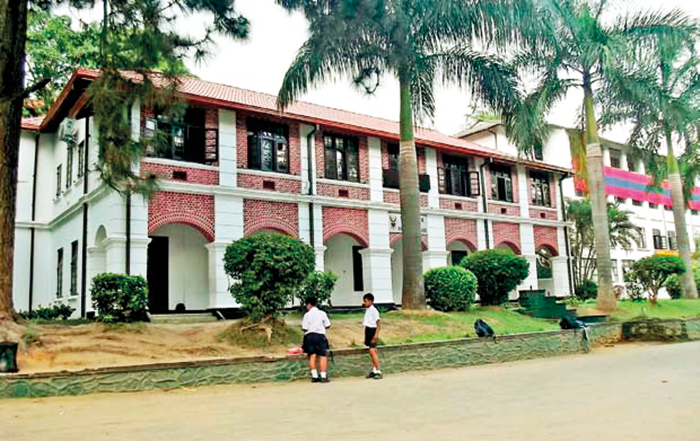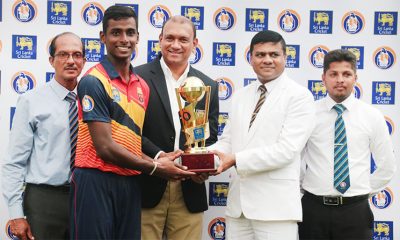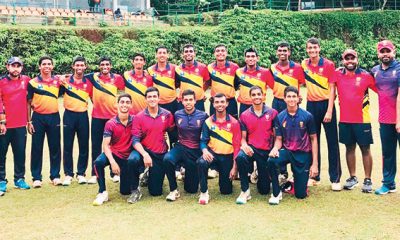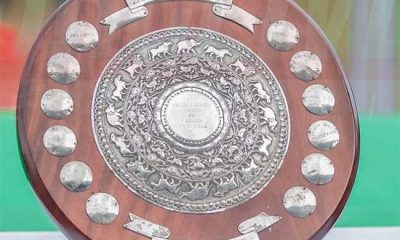Features
BURGHERS IN KANDY AND AT KINGSWOOD COLLEGE

by HM NISSANKA WARAKAULLE
Kandy had its good share of Burghers, some of whom did very well in their studies and later in their professions. Most of them were well-known and shone in their respective professions. In the medical field there were a few good doctors doing private practice with each of them having a good practice.
The two foremost doctors were Drs. Anthonisz and Winn with their dispensary on Pavilion Street, with Mrs. McGill being their matron. Dr. Frewin too had his dispensary on the same street. Later Dr. Roy Peterson set up his dispensary on Peradeniya Road, near Girls’ High School. All these doctors enjoyed a good practice.
Barbara Sansoni, the renowned artist, designer and entrepreneur was also born in Kandy.
There were a few Burgher lawyers too. Mr. Eric Dunstan Taylor, who lived in Ampitiya was a good proctor (when the legal profession was divided into advocates and proctors). He had his Law Firm with his cousin, Melville Justin Taylor. His son, Dunstan and daughter Christine both gained admission to the University of Ceylon, Peradeniya. John Henry Eaton was a well-known advocate, Thomas Edwin Beven, was also a well-known proctor in Kandy,
The University of Ceylon had a few reputed Burgher teachers such as Mr. WJF La Brooy, Fr. (Dr.) Pinto (both in European History), Dr. Ian Vanden Driesen (Economics), who married his student, Cynthia de Soysa and migrated to Australia where he became an Associate Professor in the University of Western Australia. When the Faculty of Engineering was established in Peradeniya, Prof. EOE Pereira was the Dean and later he succeeded Sir Nicholas Attygalle as the Vice-Chancellor.
Prior to these teachers there was the famous Prof. EFC Ludowyke, who was the first Professor of English in the university and first Dean of the Faculty of Arts. He was an inspiration of the English theatre on campus and an author of a number of books. It was Prof. HA Passe who succeeded Prof. Ludowyke as the Prof. of English. He had written several books and was a keen tennis player, his wife also joining in. With the establishment of the Faculty of Science in Peradeniya, well known Burghers became Professors in the Faculty, such as Prof. Hilary Cruz.
Kingswood College had as its founder Principal, Mr. LE Blaze’, who was the Principal from 04 May 1881(the day the school was started) to 1923 for 32 years, where he established all the traditions which are followed even at present. Mr. OL Gibbon was the Principal from 1929 to 1937.
Rev. FAJ Utting who took over in 1937 continued till 1942. Mr. DEA Schockman left Kingswood and was the founder Principal of Thurstan College (first known as Government Senior School), where he introduced the House system, prefects, scouting, cadeting and literary associations as in his former school.
In addition to the principals, there were Burgher teachers at Kingswood. The first trained lady teacher was Ms. AC Blaze’ from 1916 to 1918 with her forte being music. Later, when I was in school, we had Miss Clements in charge of the Lower Kindergarten, Miss Thorpe the Upper Kindergarten and Ms. Muriel Elias, the Second Standard. We also had Ms. Joyce Da Silva in the First Form.
The Burgher masters were Mr. Anton Blacker who took the physics lessons in the Upper School, Mr. Arthur Macgill who was in charge of the handicrafts section and Mr. Jansz who took geography in the University Entrance class, and Ivor Colin-Thome. Mr. Lutersz was the Vice Principal in the fifties. The Assistant Matron of the hostel was Ms. Kreltshiem.
Girls’ High School had Mrs. Labrooy, the wife of the lecturer in the university, as its principal for a few years. Mrs. McGill was the matron.
There were a number of Burgher teachers in the other schools in Kandy, especially at Trinity College, St. Anthony’s College, St, Sylvester’s College and Good Shepherd Convent.
There were many Burgher boys at Kingswood, some of whom excelled in sports and extra-curricular activities. In respect of sports, the most outstanding sportsman produced by Kingswood was Freddie White, who was at one time the best hockey goalie in Asia. Derrick Harvie had the distinction of representing Sri Lanka in hockey while still a schoolboy.
Derrick Schokman, Tony Martinesz, Kenneth Kellart, Vernon Lane, Quintus de Zylva , Augustine and Owen Mottau were outstanding cricketers, whilst Quintus de Zylva also captained the College hockey team and Derrick succeeded him the following year. Desmond Cramer was an outstanding athlete. Quintus and his elder brother, Maurice, entered the university, Maurice to the Science Faculty and Quintus to the Medical Faculty.
Quintus’ family had three sisters, all of whom attended Girls’ High School (GHS), with the youngest Audrey passing out as a doctor. William Edward Barber was the first person under 21 to called to the bar from Gray’s Inn. Cyril Charles Barber, Thomas Harold Cox, Victor Arden Forster, Gerald Percival Keuneman, Craig Phillip Ondaatjie, Jack Van Sanden and Dr. Richard Willougby Willenberg were students in the early days of Kingswood.
Kingswood had a number of brothers. Elmo and Aubrey Elias and their cousins, Brian and his younger brother (all of them were in the hostel). There were the Harvies, Stanley(who entered the university), Derrick, Clifford, Franklin, Winston and Buster. They had two sisters who attended GHS. The Martinez brothers were Tony, who was a cricketer, then Rex and Elmo, who was my classmate till he left college early.
My Burgher classmates were Derrick Harvie, Elmo, Frederick de Silva, Robert Gogerly, Ashley Gibson, Ronald Hodgson, Dennis Cox, Jeffrey Mullholland, Windsor Lockart( whose elder brother was Desmond). The only Burgher girl in our class for a short period was Amy Ludovici, whose brother Lawrence was one class above us.
GHS, Kandy too had a number of Burgher girls. Of course the most famous of them was Jean Solomons Arasanayagam, the daughter of Daniel Solomons and and Charlotte Camille Janzs, who was an internationally renowned creative writer best known for her poetry. She graduated from the University of Peradeniya and obtained her Master’s degree from the University of Strathclyde. While she won several prizes for her writing, the most prestigious being the Gratien Prize. Maureen Elhart, Lindsay sisters, Dawn and Margaret and the De Zylva sisters , Carmen, Maureen and Audrey (who passed out as a doctor from the Colombo Medical Faculty), Anne Marguerite Gunasekera (nee Blaze’), Pippa Wilson and the two Harvie sisters.
Kandy Convent too had a number of Burgher girls during the 1950s. Of them, Cyntha de Soysa, Valerie Jaimon, Marie Phillips, Carmen Rangala, Merna Schrader and Christine Taylor gained admission to the university. Florence Maud Baptist and Phyllis Drieberg were two of the earliest students at the Convent.
Trinity College too had a number of Burgher boys in the fifties, such as Keegal, Janz, Garth, Jacotine, Rodney Wood, Ralph Calendar, Furlong, Howie, Frederick Prins, Henricus, Brohier, Kenneth Hill, Solomons, Geddes, Van Langenberg, Bolling, Basil La Brooy, Cecil Balmond, William Alexander Blake(captain of boxing), Errol Warne, Goerge de Hoedt, Edward Wilhelm Buultjens, Christopher Drieberg, James Gerard Paulusz, Frederick Lorenz Ferdinands, Darley Ingleton, Dr. Terence Jansen, Rodney Jonklaas, Dr. Lorenz Arthur Prins, Dr. Anton Raymond (had to leave the Kandy Hospital as patients did not come to him as they were scared of his family name), Eustace Rulach and Charles James Staples.
Of the sportsmen, Trinity’s most famous sportsman was Duncan White, the 1948 Olympic Silver Medalist. The cricketers I remember are Errol Fernando, Eric Roles, while in rugger they had Wilhelm Balthazar, David and Rodney Frank, Edward Bartholomeusz, Eric Roles, Ken De Joedt, Irwin Howie and Glenn Van Langenburgh.
Trinity had produced two outstanding Burgher painters in George Keyt and David Paynter.
St. Anthon’y College also boasted of very good cricketers. Jack Anderson held the record for the highest score for a long time. Ronnie Stevens, who was ACM Lafir’s opening partner, followed. Later it was the Joseph brothers, Stephen and Michael who played in the team captained by Ranjith Doranegama. Dunstan Taylor gained admission to Peradeniya before his sister. Lt. Col. Godfrey Balthazaar, Rev. Fr. Dom Dunstan Barsenbach, R ev. Fr. Dom John Berenger, George Denlow, Christopher Johann Drieberg, Fr. Lawrence Hyde, Maurice Joachim (a very good rugger player), Jack Edward Robertson, Jim Rogers, Eric Dunstan Taylor and Melville Justin Taylor(cousins who had their Law Firm) and Robert Wright.
St Sylvester’s too had a few well-known Burgher boys. Raymond, Bolten and Malcolm Bulner, were boxers and RJ Victor Melder.
Like Jean Arasanayagam, Kandy could boast of another person in the literary arena. That is Carl Muller, who wrote those interesting and humorous novels such as “Jam fruit Tree”, Yakada Yaka, etc. He had an unfortunate time in three schools and finally ended up in Royal College, from where he joined the Navy as a signalman.
Unfortunately, with the change in the official language of the country, most of these Burghers migrated Down Under and did very well in their adopted country making Sri Lanka proud. Sadly, Sri Lanka’s loss was Australia’s gain.
Features
The heart-friendly health minister

by Dr Gotabhya Ranasinghe
Senior Consultant Cardiologist
National Hospital Sri Lanka
When we sought a meeting with Hon Dr. Ramesh Pathirana, Minister of Health, he graciously cleared his busy schedule to accommodate us. Renowned for his attentive listening and deep understanding, Minister Pathirana is dedicated to advancing the health sector. His openness and transparency exemplify the qualities of an exemplary politician and minister.
Dr. Palitha Mahipala, the current Health Secretary, demonstrates both commendable enthusiasm and unwavering support. This combination of attributes makes him a highly compatible colleague for the esteemed Minister of Health.
Our discussion centered on a project that has been in the works for the past 30 years, one that no other minister had managed to advance.
Minister Pathirana, however, recognized the project’s significance and its potential to revolutionize care for heart patients.
The project involves the construction of a state-of-the-art facility at the premises of the National Hospital Colombo. The project’s location within the premises of the National Hospital underscores its importance and relevance to the healthcare infrastructure of the nation.
This facility will include a cardiology building and a tertiary care center, equipped with the latest technology to handle and treat all types of heart-related conditions and surgeries.
Securing funding was a major milestone for this initiative. Minister Pathirana successfully obtained approval for a $40 billion loan from the Asian Development Bank. With the funding in place, the foundation stone is scheduled to be laid in September this year, and construction will begin in January 2025.
This project guarantees a consistent and uninterrupted supply of stents and related medications for heart patients. As a result, patients will have timely access to essential medical supplies during their treatment and recovery. By securing these critical resources, the project aims to enhance patient outcomes, minimize treatment delays, and maintain the highest standards of cardiac care.
Upon its fruition, this monumental building will serve as a beacon of hope and healing, symbolizing the unwavering dedication to improving patient outcomes and fostering a healthier society.We anticipate a future marked by significant progress and positive outcomes in Sri Lanka’s cardiovascular treatment landscape within the foreseeable timeframe.
Features
A LOVING TRIBUTE TO JESUIT FR. ALOYSIUS PIERIS ON HIS 90th BIRTHDAY

by Fr. Emmanuel Fernando, OMI
Jesuit Fr. Aloysius Pieris (affectionately called Fr. Aloy) celebrated his 90th birthday on April 9, 2024 and I, as the editor of our Oblate Journal, THE MISSIONARY OBLATE had gone to press by that time. Immediately I decided to publish an article, appreciating the untiring selfless services he continues to offer for inter-Faith dialogue, the renewal of the Catholic Church, his concern for the poor and the suffering Sri Lankan masses and to me, the present writer.
It was in 1988, when I was appointed Director of the Oblate Scholastics at Ampitiya by the then Oblate Provincial Fr. Anselm Silva, that I came to know Fr. Aloy more closely. Knowing well his expertise in matters spiritual, theological, Indological and pastoral, and with the collaborative spirit of my companion-formators, our Oblate Scholastics were sent to Tulana, the Research and Encounter Centre, Kelaniya, of which he is the Founder-Director, for ‘exposure-programmes’ on matters spiritual, biblical, theological and pastoral. Some of these dimensions according to my view and that of my companion-formators, were not available at the National Seminary, Ampitiya.
Ever since that time, our Oblate formators/ accompaniers at the Oblate Scholasticate, Ampitiya , have continued to send our Oblate Scholastics to Tulana Centre for deepening their insights and convictions regarding matters needed to serve the people in today’s context. Fr. Aloy also had tried very enthusiastically with the Oblate team headed by Frs. Oswald Firth and Clement Waidyasekara to begin a Theologate, directed by the Religious Congregations in Sri Lanka, for the contextual formation/ accompaniment of their members. It should very well be a desired goal of the Leaders / Provincials of the Religious Congregations.
Besides being a formator/accompanier at the Oblate Scholasticate, I was entrusted also with the task of editing and publishing our Oblate journal, ‘The Missionary Oblate’. To maintain the quality of the journal I continue to depend on Fr. Aloy for his thought-provoking and stimulating articles on Biblical Spirituality, Biblical Theology and Ecclesiology. I am very grateful to him for his generous assistance. Of late, his writings on renewal of the Church, initiated by Pope St. John XX111 and continued by Pope Francis through the Synodal path, published in our Oblate journal, enable our readers to focus their attention also on the needed renewal in the Catholic Church in Sri Lanka. Fr. Aloy appreciated very much the Synodal path adopted by the Jesuit Pope Francis for the renewal of the Church, rooted very much on prayerful discernment. In my Religious and presbyteral life, Fr.Aloy continues to be my spiritual animator / guide and ongoing formator / acccompanier.
Fr. Aloysius Pieris, BA Hons (Lond), LPh (SHC, India), STL (PFT, Naples), PhD (SLU/VC), ThD (Tilburg), D.Ltt (KU), has been one of the eminent Asian theologians well recognized internationally and one who has lectured and held visiting chairs in many universities both in the West and in the East. Many members of Religious Congregations from Asian countries have benefited from his lectures and guidance in the East Asian Pastoral Institute (EAPI) in Manila, Philippines. He had been a Theologian consulted by the Federation of Asian Bishops’ Conferences for many years. During his professorship at the Gregorian University in Rome, he was called to be a member of a special group of advisers on other religions consulted by Pope Paul VI.
Fr. Aloy is the author of more than 30 books and well over 500 Research Papers. Some of his books and articles have been translated and published in several countries. Among those books, one can find the following: 1) The Genesis of an Asian Theology of Liberation (An Autobiographical Excursus on the Art of Theologising in Asia, 2) An Asian Theology of Liberation, 3) Providential Timeliness of Vatican 11 (a long-overdue halt to a scandalous millennium, 4) Give Vatican 11 a chance, 5) Leadership in the Church, 6) Relishing our faith in working for justice (Themes for study and discussion), 7) A Message meant mainly, not exclusively for Jesuits (Background information necessary for helping Francis renew the Church), 8) Lent in Lanka (Reflections and Resolutions, 9) Love meets wisdom (A Christian Experience of Buddhism, 10) Fire and Water 11) God’s Reign for God’s poor, 12) Our Unhiddden Agenda (How we Jesuits work, pray and form our men). He is also the Editor of two journals, Vagdevi, Journal of Religious Reflection and Dialogue, New Series.
Fr. Aloy has a BA in Pali and Sanskrit from the University of London and a Ph.D in Buddhist Philosophy from the University of Sri Lankan, Vidyodaya Campus. On Nov. 23, 2019, he was awarded the prestigious honorary Doctorate of Literature (D.Litt) by the Chancellor of the University of Kelaniya, the Most Venerable Welamitiyawe Dharmakirthi Sri Kusala Dhamma Thera.
Fr. Aloy continues to be a promoter of Gospel values and virtues. Justice as a constitutive dimension of love and social concern for the downtrodden masses are very much noted in his life and work. He had very much appreciated the commitment of the late Fr. Joseph (Joe) Fernando, the National Director of the Social and Economic Centre (SEDEC) for the poor.
In Sri Lanka, a few religious Congregations – the Good Shepherd Sisters, the Christian Brothers, the Marist Brothers and the Oblates – have invited him to animate their members especially during their Provincial Congresses, Chapters and International Conferences. The mainline Christian Churches also have sought his advice and followed his seminars. I, for one, regret very much, that the Sri Lankan authorities of the Catholic Church –today’s Hierarchy—- have not sought Fr.
Aloy’s expertise for the renewal of the Catholic Church in Sri Lanka and thus have not benefited from the immense store of wisdom and insight that he can offer to our local Church while the Sri Lankan bishops who governed the Catholic church in the immediate aftermath of the Second Vatican Council (Edmund Fernando OMI, Anthony de Saram, Leo Nanayakkara OSB, Frank Marcus Fernando, Paul Perera,) visited him and consulted him on many matters. Among the Tamil Bishops, Bishop Rayappu Joseph was keeping close contact with him and Bishop J. Deogupillai hosted him and his team visiting him after the horrible Black July massacre of Tamils.
Features
A fairy tale, success or debacle

Sri Lanka-Singapore Free Trade Agreement
By Gomi Senadhira
senadhiragomi@gmail.com
“You might tell fairy tales, but the progress of a country cannot be achieved through such narratives. A country cannot be developed by making false promises. The country moved backward because of the electoral promises made by political parties throughout time. We have witnessed that the ultimate result of this is the country becoming bankrupt. Unfortunately, many segments of the population have not come to realize this yet.” – President Ranil Wickremesinghe, 2024 Budget speech
Any Sri Lankan would agree with the above words of President Wickremesinghe on the false promises our politicians and officials make and the fairy tales they narrate which bankrupted this country. So, to understand this, let’s look at one such fairy tale with lots of false promises; Ranil Wickremesinghe’s greatest achievement in the area of international trade and investment promotion during the Yahapalana period, Sri Lanka-Singapore Free Trade Agreement (SLSFTA).
It is appropriate and timely to do it now as Finance Minister Wickremesinghe has just presented to parliament a bill on the National Policy on Economic Transformation which includes the establishment of an Office for International Trade and the Sri Lanka Institute of Economics and International Trade.
Was SLSFTA a “Cleverly negotiated Free Trade Agreement” as stated by the (former) Minister of Development Strategies and International Trade Malik Samarawickrama during the Parliamentary Debate on the SLSFTA in July 2018, or a colossal blunder covered up with lies, false promises, and fairy tales? After SLSFTA was signed there were a number of fairy tales published on this agreement by the Ministry of Development Strategies and International, Institute of Policy Studies, and others.
However, for this article, I would like to limit my comments to the speech by Minister Samarawickrama during the Parliamentary Debate, and the two most important areas in the agreement which were covered up with lies, fairy tales, and false promises, namely: revenue loss for Sri Lanka and Investment from Singapore. On the other important area, “Waste products dumping” I do not want to comment here as I have written extensively on the issue.
1. The revenue loss
During the Parliamentary Debate in July 2018, Minister Samarawickrama stated “…. let me reiterate that this FTA with Singapore has been very cleverly negotiated by us…. The liberalisation programme under this FTA has been carefully designed to have the least impact on domestic industry and revenue collection. We have included all revenue sensitive items in the negative list of items which will not be subject to removal of tariff. Therefore, 97.8% revenue from Customs duty is protected. Our tariff liberalisation will take place over a period of 12-15 years! In fact, the revenue earned through tariffs on goods imported from Singapore last year was Rs. 35 billion.
The revenue loss for over the next 15 years due to the FTA is only Rs. 733 million– which when annualised, on average, is just Rs. 51 million. That is just 0.14% per year! So anyone who claims the Singapore FTA causes revenue loss to the Government cannot do basic arithmetic! Mr. Speaker, in conclusion, I call on my fellow members of this House – don’t mislead the public with baseless criticism that is not grounded in facts. Don’t look at petty politics and use these issues for your own political survival.”
I was surprised to read the minister’s speech because an article published in January 2018 in “The Straits Times“, based on information released by the Singaporean Negotiators stated, “…. With the FTA, tariff savings for Singapore exports are estimated to hit $10 million annually“.
As the annual tariff savings (that is the revenue loss for Sri Lanka) calculated by the Singaporean Negotiators, Singaporean $ 10 million (Sri Lankan rupees 1,200 million in 2018) was way above the rupees’ 733 million revenue loss for 15 years estimated by the Sri Lankan negotiators, it was clear to any observer that one of the parties to the agreement had not done the basic arithmetic!
Six years later, according to a report published by “The Morning” newspaper, speaking at the Committee on Public Finance (COPF) on 7th May 2024, Mr Samarawickrama’s chief trade negotiator K.J. Weerasinghehad had admitted “…. that forecasted revenue loss for the Government of Sri Lanka through the Singapore FTA is Rs. 450 million in 2023 and Rs. 1.3 billion in 2024.”
If these numbers are correct, as tariff liberalisation under the SLSFTA has just started, we will pass Rs 2 billion very soon. Then, the question is how Sri Lanka’s trade negotiators made such a colossal blunder. Didn’t they do their basic arithmetic? If they didn’t know how to do basic arithmetic they should have at least done their basic readings. For example, the headline of the article published in The Straits Times in January 2018 was “Singapore, Sri Lanka sign FTA, annual savings of $10m expected”.
Anyway, as Sri Lanka’s chief negotiator reiterated at the COPF meeting that “…. since 99% of the tariffs in Singapore have zero rates of duty, Sri Lanka has agreed on 80% tariff liberalisation over a period of 15 years while expecting Singapore investments to address the imbalance in trade,” let’s turn towards investment.
Investment from Singapore
In July 2018, speaking during the Parliamentary Debate on the FTA this is what Minister Malik Samarawickrama stated on investment from Singapore, “Already, thanks to this FTA, in just the past two-and-a-half months since the agreement came into effect we have received a proposal from Singapore for investment amounting to $ 14.8 billion in an oil refinery for export of petroleum products. In addition, we have proposals for a steel manufacturing plant for exports ($ 1 billion investment), flour milling plant ($ 50 million), sugar refinery ($ 200 million). This adds up to more than $ 16.05 billion in the pipeline on these projects alone.
And all of these projects will create thousands of more jobs for our people. In principle approval has already been granted by the BOI and the investors are awaiting the release of land the environmental approvals to commence the project.
I request the Opposition and those with vested interests to change their narrow-minded thinking and join us to develop our country. We must always look at what is best for the whole community, not just the few who may oppose. We owe it to our people to courageously take decisions that will change their lives for the better.”
According to the media report I quoted earlier, speaking at the Committee on Public Finance (COPF) Chief Negotiator Weerasinghe has admitted that Sri Lanka was not happy with overall Singapore investments that have come in the past few years in return for the trade liberalisation under the Singapore-Sri Lanka Free Trade Agreement. He has added that between 2021 and 2023 the total investment from Singapore had been around $162 million!
What happened to those projects worth $16 billion negotiated, thanks to the SLSFTA, in just the two-and-a-half months after the agreement came into effect and approved by the BOI? I do not know about the steel manufacturing plant for exports ($ 1 billion investment), flour milling plant ($ 50 million) and sugar refinery ($ 200 million).
However, story of the multibillion-dollar investment in the Petroleum Refinery unfolded in a manner that would qualify it as the best fairy tale with false promises presented by our politicians and the officials, prior to 2019 elections.
Though many Sri Lankans got to know, through the media which repeatedly highlighted a plethora of issues surrounding the project and the questionable credentials of the Singaporean investor, the construction work on the Mirrijiwela Oil Refinery along with the cement factory began on the24th of March 2019 with a bang and Minister Ranil Wickremesinghe and his ministers along with the foreign and local dignitaries laid the foundation stones.
That was few months before the 2019 Presidential elections. Inaugurating the construction work Prime Minister Ranil Wickremesinghe said the projects will create thousands of job opportunities in the area and surrounding districts.
The oil refinery, which was to be built over 200 acres of land, with the capacity to refine 200,000 barrels of crude oil per day, was to generate US$7 billion of exports and create 1,500 direct and 3,000 indirect jobs. The construction of the refinery was to be completed in 44 months. Four years later, in August 2023 the Cabinet of Ministers approved the proposal presented by President Ranil Wickremesinghe to cancel the agreement with the investors of the refinery as the project has not been implemented! Can they explain to the country how much money was wasted to produce that fairy tale?
It is obvious that the President, ministers, and officials had made huge blunders and had deliberately misled the public and the parliament on the revenue loss and potential investment from SLSFTA with fairy tales and false promises.
As the president himself said, a country cannot be developed by making false promises or with fairy tales and these false promises and fairy tales had bankrupted the country. “Unfortunately, many segments of the population have not come to realize this yet”.
(The writer, a specialist and an activist on trade and development issues . )
























